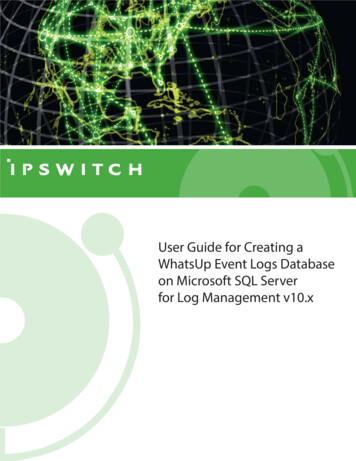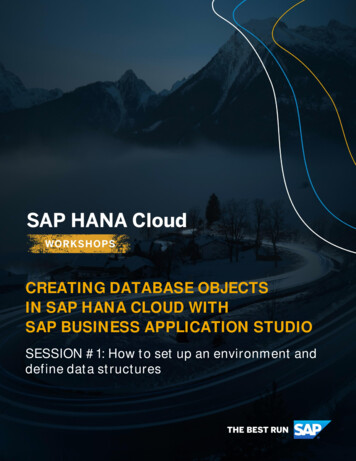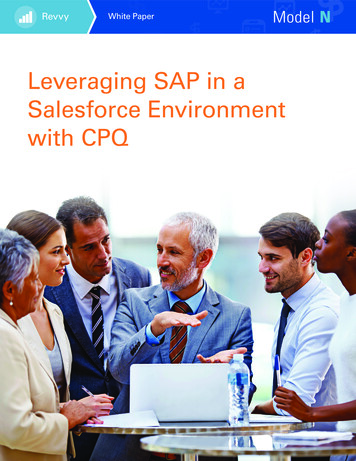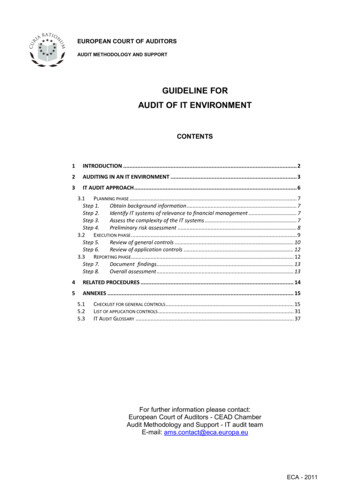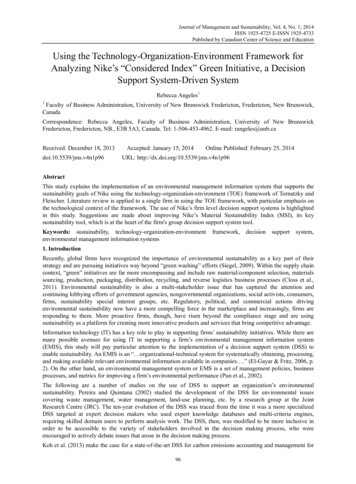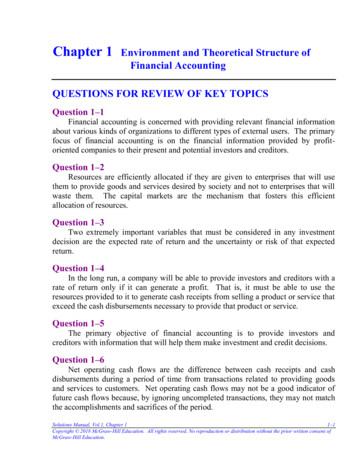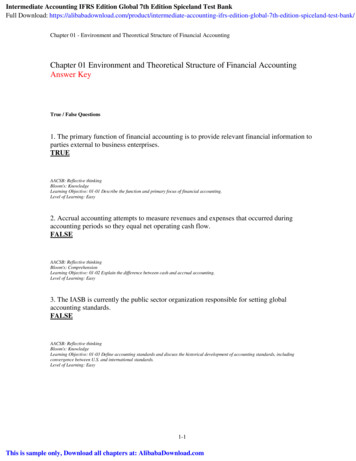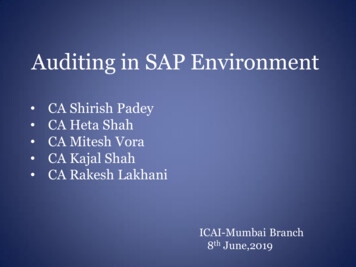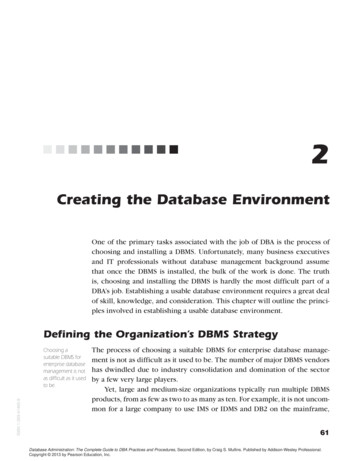
Transcription
2Creating the Database EnvironmentOne of the primary tasks associated with the job of DBA is the process ofchoosing and installing a DBMS. Unfortunately, many business executivesand IT professionals without database management background assumethat once the DBMS is installed, the bulk of the work is done. The truthis, choosing and installing the DBMS is hardly the most difficult part of aDBA’s job. Establishing a usable database environment requires a great dealof skill, knowledge, and consideration. This chapter will outline the principles involved in establishing a usable database environment.Defining the Organization’s DBMS StrategyISBN 1-269-41465-8Choosing asuitable DBMS forenterprise databasemanagement is notas difficult as it usedto be.The process of choosing a suitable DBMS for enterprise database management is not as difficult as it used to be. The number of major DBMS vendorshas dwindled due to industry consolidation and domination of the sectorby a few very large players.Yet, large and medium-size organizations typically run multiple DBMSproducts, from as few as two to as many as ten. For example, it is not uncommon for a large company to use IMS or IDMS and DB2 on the mainframe,61Database Administration: The Complete Guide to DBA Practices and Procedures, Second Edition, by Craig S. Mullins. Published by Addison-Wesley Professional.Copyright 2013 by Pearson Education, Inc.
62The DBA groupshould be empowered to make theDBMS decisions forthe organization.Chapter 2Creating the Database EnvironmentDatabase Administration: The Complete Guide to DBA Practices and Procedures, Second Edition, by Craig S. Mullins. Published by Addison-Wesley Professional.Copyright 2013 by Pearson Education, Inc.ISBN 1-269-41465-8Oracle and MySQL on several different UNIX servers, Microsoft SQL Serveron Windows servers, as well as pockets of other DBMS products such asSybase, Ingres, Adabas, and PostgreSQL on various platforms, not to mention single-user PC DBMS products such as Microsoft Access, Paradox, andFileMaker. Who chose to install all these DBMSs and why?Unfortunately, often the answer is that not much thought and planning went into the decision-making process. Sometimes the decision topurchase and install a new DBMS is driven by a business need or a newapplication. This is reasonable if your organization has no DBMS and mustpurchase one for the first time. This is rarely the case, though. Regardlessof whether a DBMS exists on-site, a new DBMS is often viewed as a requirement for a new application. Sometimes a new DBMS product is purchasedand installed without first examining if the application could be successfully implemented using an existing DBMS. Or, more likely, the DBAs knowthe application can be implemented using an existing DBMS but lack theorganizational power or support to reject a new DBMS proposal.There are other reasons for the existence of multiple DBMS platformsin a single organization. Perhaps the company purchased a commercial offthe-shelf application package that does not run on any of the current DBMSplatforms. Sometimes the decision to buy a new DBMS is driven by thedesire to support the latest and greatest technology. For example, manymainframe shops moving from a hierarchic (IMS) or CODASYL (IDMS)database model to the relational model deployed DB2, resulting in an additional DBMS to learn and support. Then, when client/server computingbecame popular, additional DBMSs were implemented on UNIX, Linux, andWindows servers.Once a DBMS is installed, removal can be difficult because of incompatibilities among the different DBMSs and the necessity of converting application code. Furthermore, when a new DBMS is installed, old applicationsand databases are usually not migrated to it. The old DBMS remains andmust continue to be supported. This complicates the DBA’s job.So what should be done? Well, the DBA group should be empoweredto make the DBMS decisions for the organization. No business unit shouldbe allowed to purchase a DBMS without the permission of the DBA group.This is a difficult provision to implement and even more difficult to enforce.Business politics often work against the DBA group because it frequentlypossesses less organizational power than other business executives.
Defining the Organization’s DBMS Strategy63Choosing a DBMSWhen choosinga DBMS, select aproduct from atier-1 vendor.The DBA group should set a policy regarding the DBMS products to besupported within the organization. Whenever possible, the policy shouldminimize the number of different DBMS products. For a shop with multipleoperating systems and multiple types of hardware, choose a default DBMSfor the platform. Discourage deviation from the default unless a compellingbusiness case exists—a business case that passes the technical inspectionof the DBA group.Most of the major DBMS products have similar features, and if the feature or functionality does not exist today, it probably will within 18 to 24months. So, exercise caution before deciding to choose a DBMS based solelyon its ability to support a specific feature.When choosing a DBMS, it is wise to select a product from a tier-1 vendor as listed in Table 2.1. Tier 1 represents the largest vendors having themost heavily implemented and supported products on the market. You cannot go wrong with DB2 or Oracle. Both are popular and support just aboutany type of database. Another major player is Microsoft SQL Server, but onlyfor Windows platforms. DB2 and Oracle run on multiple platforms rangingfrom mainframe to UNIX, as well as Windows and even handheld devices.Choosing a DBMS other than these three should be done only under specific circumstances.After the big three come MySQL, Sybase, Teradata, and Informix. Table 2.2lists these tier-2 DBMS vendors. All of these offerings are quality DBMSISBN 1-269-41465-8Table 2.1 Tier-1 DBMS VendorsDBMS VendorDBMS ProductIBM CorporationNew Orchard RoadArmonk, NY 10504Phone: (914) 499-1900DB2Oracle Corporation500 Oracle ParkwayRedwood Shores, CA 94065Phone: (650) 506-7000OracleMicrosoft CorporationOne Microsoft WayRedmond, WA 98052Phone: (425) 882-8080SQL ServerDatabase Administration: The Complete Guide to DBA Practices and Procedures, Second Edition, by Craig S. Mullins. Published by Addison-Wesley Professional.Copyright 2013 by Pearson Education, Inc.
64Chapter 2Creating the Database EnvironmentTable 2.2 Tier-2 DBMS VendorsChoosing any of thelower-tier candidatesinvolves incurringadditional risk.DBMS VendorDBMS ProductIBM CorporationNew Orchard RoadArmonk, NY 10504Phone: (914) 499-1900Informix Dynamic ServerSybase Inc. (an SAP Company)6475 Christie AvenueEmeryville, CA 94608Phone: (510) 922-3500Adaptive Server EnterpriseTeradata Corporation10000 Innovation DriveDayton, OH 45342Phone: (937) 242-4030TeradataMySQL (a subsidiary of Oracle Corporation)Phone: (208) 338-8100MySQLproducts, but their installed base is smaller, their products are engineeredand marketed for niche purposes, or the companies are smaller with fewerresources than the Big Three (IBM, Oracle, and Microsoft), so there is somerisk in choosing a DBMS from tier 2 instead of tier 1. However, there may besolid reasons for deploying a tier-2 solution, such as the high performanceoffered by Informix or the data warehousing and analytics capabilities ofTeradata.Of course, there are other DBMS products on the market, many ofwhich are fine products and worthy of consideration for specialty processing, certain predefined needs, and niche roles. If your company is heavilyinto the open-source software movement, PostgreSQL, EnterpriseDB, orMySQL might be viable options. If an object DBMS is important for a specific project, you might consider ObjectDesign or Versant. And there are avariety of NoSQL DBMS offerings available, too, such as Hadoop, Cassandra,and MongoDB.1However, for the bulk of your data management needs, a DBMS from atier-1, or perhaps tier-2, DBMS vendor will deliver sufficient functionalitywith minimal risk. A myriad of DBMS products are available, each withDatabase Administration: The Complete Guide to DBA Practices and Procedures, Second Edition, by Craig S. Mullins. Published by Addison-Wesley Professional.Copyright 2013 by Pearson Education, Inc.ISBN 1-269-41465-81. If you prefer commercial software over open source, there are commercial offeringsof some of the NoSQL products. For example, DataStax is based on Cassandra.
Defining the Organization’s DBMS Strategy65certain features that make them worthy of consideration on a case-by-casebasis. Choosing any of the lower-tier candidates—even such major namesas Software AG’s Adabas and Actian’s Ingres—involves incurring additionalrisk. Refer to Appendix B for a list of DBMS vendors.I do not want it to sound as if the selection of a DBMS is a no-brainer.You will need a strategy and a plan for selecting the appropriate DBMS foryour specific situation. When choosing a DBMS, be sure to consider eachof these factors: Operating system support. Does the DBMS support the operatingsystems in use at your organization, including the versions that youare currently using and plan on using? Type of organization. Take into consideration the corporate philosophy when you choose a DBMS. Some organizations are veryconservative and like to keep a tight rein on their environments;these organizations tend to gravitate toward traditional mainframeenvironments. Government operations, financial institutions, andinsurance and health companies usually tend to be conservative.More-liberal organizations are often willing to consider alternativearchitectures. It is not uncommon for manufacturing companies,dot-coms, and universities to be less conservative. Finally, somecompanies just do not trust Windows as a mission-critical environment and prefer to use UNIX; this rules out some database vendors(Microsoft SQL Server, in particular).ISBN 1-269-41465-8Benchmarks areconstantly updatedto show newand improvedperformancemeasurements. Benchmarks. What performance benchmarks are available from theDBMS vendor and other users of the DBMS? The Transaction Processing Performance Council (TPC) publishes official database performance benchmarks that can be used as a guideline for the basicoverall performance of many different types of database processing.(Refer to the sidebar “The Transaction Processing PerformanceCouncil” for more details.) In general, performance benchmarks canbe useful as a broad indicator of database performance but shouldnot be the only determinant when selecting a DBMS. Many of theTPC benchmarks are run against database implementations that arenot representative of most production database systems and therefore are not indicative of the actual performance of a particularDBMS. In addition, benchmarks are constantly updated to show newDatabase Administration: The Complete Guide to DBA Practices and Procedures, Second Edition, by Craig S. Mullins. Published by Addison-Wesley Professional.Copyright 2013 by Pearson Education, Inc.
66Chapter 2Creating the Database Environmentand improved performance measurements for each of the majorDBMS products, rendering the benchmark “winners” obsolete veryquickly. Scalability. Does the DBMS support the number of users and database sizes you intend to implement? How are large databases built,supported, and maintained—easily or with a lot of pain? Are thereindependent users who can confirm the DBMS vendor’s scalabilityclaims? Availability of supporting software tools. Are the supporting toolsyou require available for the DBMS? These items may include queryand analysis tools, data warehousing support tools, database administration tools, backup and recovery tools, performance-monitoringThe Transaction Processing PerformanceCouncil (TPC)The Transaction Processing Performance Council is an independent, not-for-profit organization that manages and administers performance benchmark tests. Its mission is to definetransaction processing and database benchmarks to provide the industry with objective,verifiable performance data. TPC benchmarks measure and evaluate computer functionsand operations.The definition of transaction espoused by the TPC is a business one. A typical TPC transaction includes the database updates for things such as inventory control (goods), airlinereservations (services), and banking (money).The benchmarks produced by the TPC measure performance in terms of how manytransactions a given system and database can perform per unit of time, for example, number of transactions per second. The TPC defines three benchmarks: TPC-C, for planned production workload in a transaction environment TPC-H, a decision support benchmark consisting of a suite of business-oriented adhoc queries and concurrent data modifications TPC-E, an updated OLTP workload (based on financial transaction processing)Database Administration: The Complete Guide to DBA Practices and Procedures, Second Edition, by Craig S. Mullins. Published by Addison-Wesley Professional.Copyright 2013 by Pearson Education, Inc.ISBN 1-269-41465-8Additional information and in-depth definitions of these benchmarks can be found atthe TPC Web site at www.tpc.org (see Figure 2.1).
Defining the Organization’s DBMS Strategy67tools, capacity-planning tools, database utilities, and support forvarious programming languages. Technicians. Is there a sufficient supply of skilled database professionals for the DBMS? Consider your needs in terms of DBAs, technical support personnel (system programmers and administrators,operations analysts, etc.), and application programmers.ISBN 1-269-41465-8 Cost of ownership. What is the total cost of ownership of theDBMS? DBMS vendors charge wildly varying prices for their technology. Total cost of ownership should be calculated as a combinationof the license cost of the DBMS; the license cost of any requiredsupporting software; the cost of database professionals to program,support, and administer the DBMS; and the cost of the computingresources required to operate the DBMS.Figure 2.1 The TPC Web siteDatabase Administration: The Complete Guide to DBA Practices and Procedures, Second Edition, by Craig S. Mullins. Published by Addison-Wesley Professional.Copyright 2013 by Pearson Education, Inc.
68Chapter 2Creating the Database Environment Release schedule. How often does the DBMS vendor release a newversion? Some vendors have rapid release cycles, with new releasescoming out every 12 to 18 months. This can be good or bad,depending on your approach. If you want cutting-edge features, arapid release cycle is good. However, if your shop is more conservative, a DBMS that changes frequently can be difficult to support.A rapid release cycle will cause conservative organizations eitherto upgrade more frequently than they would like or to live withoutdated DBMS software that is unlikely to have the same level ofsupport as the latest releases. Reference customers. Will the DBMS vendor supply current user references? Can you find other users on your own who might providemore impartial answers? Speak with current users to elicit issuesand concerns you may have overlooked. How is support? Does thevendor respond well to problems? Do things generally work asadvertised? Are there a lot of bug fixes that must be applied continuously? What is the quality of new releases? These questions can beanswered only by the folks in the trenches.When choosing a DBMS, be sure to take into account the complexity ofthe products. DBMS software is very complex and is getting more complexwith each new release. Functionality that used to be supported only withadd-on software or independent programs is increasingly being added asfeatures of the DBMS, as shown in Figure 2.2. You will need to plan for andsupport all the features of the DBMS. Even if there is no current requirement for certain features, once you implement the DBMS the programmersand developers will find a reason to use just about anything the vendorthrew into it. It is better to plan and be prepared than to allow features tobe used without a plan for supporting them.DBMS ArchitecturesThe supporting architecture for the DBMS environment is very criticalto the success of the database applications. One wrong choice or poorlyimplemented component of the overall architecture can cause poor performance, downtime, or unstable applications.When mainframes dominated enterprise computing, DBMS architecture was a simpler concern. Everything ran on the mainframe, and thatDatabase Administration: The Complete Guide to DBA Practices and Procedures, Second Edition, by Craig S. Mullins. Published by Addison-Wesley Professional.Copyright 2013 by Pearson Education, Inc.ISBN 1-269-41465-8The supportingarchitecture for theDBMS environmentis very critical to thesuccess of the database applications.
69Defining the Organization’s DBMS StrategyUnstructuredDataOLTP andParallelQueryDatabaseManagementSystemOLAP andAnalyticsData Extract,Transform,and LoadFigure 2.2 Convergence of features and functionality in DBMS softwareISBN 1-269-41465-8Four levels of DBMSarchitecture areavailable: enterprise,departmental, personal, and mobile.was that. However, today the IT infrastructure is distributed and heterogeneous. The overall architecture—even for a mainframe DBMS—will probably consist of multiple platforms and interoperating system software. Ateam consisting of business and IT experts, rather than a single person orgroup, should make the final architecture decision. Business experts shouldinclude representatives from various departments, as well as from accounting and legal for software contract issues. Database administration representatives (DA, DBA, and SA), as well as members of the networking group,operating system experts, operations control personnel, programmingexperts, and any other interested parties, should be included in this team.Furthermore, be sure that the DBMS you select is appropriate for thenature and type of processing you plan to implement. Four levels of DBMSarchitecture are available: enterprise, departmental, personal, and mobile.An enterprise DBMS is designed for scalability and high performance.An enterprise DBMS must be capable of supporting very large databases, alarge number of concurrent users, and multiple types of applications. Theenterprise DBMS runs on a large-scale machine, typically a mainframe or ahigh-end server running UNIX, Linux, or Windows Server. Furthermore, anenterprise DBMS offers all the “bells and whistles” available from the DBMSvendor. Multiprocessor support, support for parallel queries, and otheradvanced DBMS features are core components of an enterprise DBMS.Database Administration: The Complete Guide to DBA Practices and Procedures, Second Edition, by Craig S. Mullins. Published by Addison-Wesley Professional.Copyright 2013 by Pearson Education, Inc.
70Chapter 2Creating the Database Environment2. FileMaker is offered in a professional, multiuser version, too.Database Administration: The Complete Guide to DBA Practices and Procedures, Second Edition, by Craig S. Mullins. Published by Addison-Wesley Professional.Copyright 2013 by Pearson Education, Inc.ISBN 1-269-41465-8A departmental DBMS, sometimes referred to as a workgroup DBMS,serves the middle ground. The departmental DBMS supports small to medium-size workgroups within an organization; typically, it runs on a UNIX,Linux, or Windows server. The dividing line between a departmental database server and an enterprise database server is quite gray. Hardware andsoftware upgrades can allow a departmental DBMS to tackle tasks thatpreviously could be performed only by an enterprise DBMS. The steadilyfalling cost of departmental hardware and software components furthercontributes to lowering the total cost of operation and enabling a workgroup environment to scale up to serve the enterprise.A personal DBMS is designed for a single user, typically on a low- tome
enterprise database management is not as difficult as it used to be. Mullins_Book.indb 61 9/19/12 11:18 AM ISBN 1-269-41465-8 Database Administration: The Complete Guide to DBA Practices and Procedures, Second Edition, by Cr


